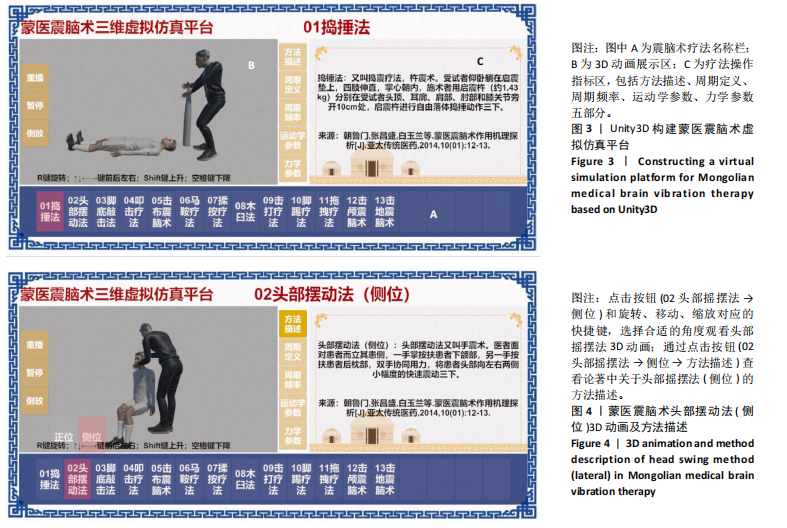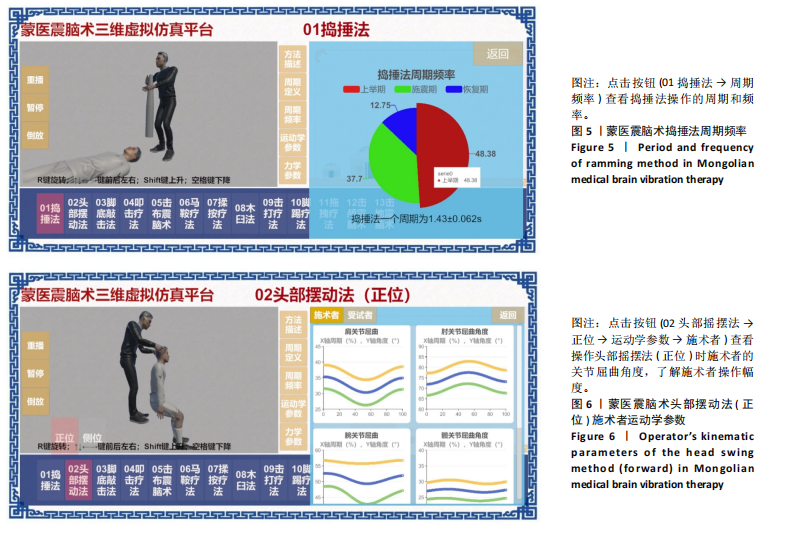中国组织工程研究 ›› 2025, Vol. 29 ›› Issue (18): 3826-3832.doi: 10.12307/2025.641
• 组织构建与生物力学 tissue construction and biomechanics • 上一篇 下一篇
基于三维运动捕捉技术构建蒙医震脑术三维虚拟仿真平台的视觉呈现
白 雪1,王 星2,3,洪国萍4,贾茹铄4,韩 琦5,郭怀钰5,牛泓凯5,张少杰2,3,朝鲁门6
- 内蒙古医科大学,1医学实验中心,2基础医学院解剖学教研室,3数字医学中心,内蒙古自治区呼和浩特市 010110;4内蒙古自治区残疾人康复服务中心,内蒙古自治区呼和浩特市 010010;5内蒙古大学计算机学院,内蒙古自治区呼和浩特市 010021;6包头市蒙医中医医院,内蒙古自治区包头市 014040
A three-dimensional virtual simulation platform for Mongolian medical brain vibration therapy constructed based on the three-dimensional motion capture technology
Bai Xue1, Wang Xing2, 3, Hong Guoping4, Jia Rushuo4, Han Qi5, Guo Huaiyu5, Niu Hongkai5, Zhang Shaojie2, 3, Chao Lumen6
- 1Medical Experimental Center of Inner Mongolia Medical University, Hohhot 010110, Inner Mongolia Autonomous Region, China; 2Department of Anatomy, School of Basic Medicine, Inner Mongolia Medical University, Hohhot 010110, Inner Mongolia Autonomous Region, China; 3Digital Medical Center of Inner Mongolia Medical University, Hohhot 010110, Inner Mongolia Autonomous Region, China; 4Inner Mongolia Rehabilitation Service Center for the Disabled, Hohhot 010010, Inner Mongolia Autonomous Region, China; 5School of Computer Science, Inner Mongolia University, Hohhot 010021, Inner Mongolia Autonomous Region, China; 6Baotou Mongolian Medicine Chinese Medicine Hospital, Baotou 014040, Inner Mongolia Autonomous Region, China
摘要:
文题释义:
蒙医震脑术:蒙古族人民由于长期的骑马和游牧生活,经常出现摔伤等现象,因此对脑震荡病症及其防治有较深的认识。在历史演变过程中逐渐形成了蒙医震脑术特色疗法,如棒击法、打击法、紧拉法、捣捶法、敲打法等。
三维运动捕捉技术:利用高分辨率的红外摄像机和计算机图像学,记录物体在真实三维空间中的运动轨迹,并在虚拟三维空间中重建运动物体每一时刻运动状态的高新技术。
背景:基于三维运动捕捉技术可以构建精准的、客观量化的医学虚拟仿真模型,有利于临床学习者精准、深入理解和掌握各种传统疗术。目前中医虚拟仿真模型已有报道,但蒙医传统疗术的虚拟仿真模型尚未见报道。
目的:构建一种基于三维运动捕捉技术的交互式三维可视化的蒙医震脑术虚拟仿真模型。
方法:使用Motion Analysis三维光学运动捕捉系统和足底测力台采集蒙医专家的运动捕捉数据,在Motion Builder软件中构建震脑术三维动作模型,使用Maya软件构建角色模型并与动作模型相匹配,运动Unity3D软件构建蒙医震脑术虚拟仿真系统,系统整合蒙医震脑术操作3D动画、运动学和动力学参数信息。
结果与结论:通过三维运动捕捉技术和计算机仿真重现蒙医震脑术操作,能够显示施术者和受试者的运动姿态,记录关节运动的关键空间位置参数与变化情况,得出运动过程中的运动学、动力学参数。运用交互式三维虚拟仿真技术,实现蒙医震脑术的三维虚拟仿真的视觉呈现,为蒙医震脑术手法的标准化、数字化、可视化研究奠定基础。
https://orcid.org/0009-0004-4254-7140(白雪);https://orcid.org/0000-0003-0059-4921(王星);https://orcid.org/0000-0002-1205-7624(张少杰)
中国组织工程研究杂志出版内容重点:组织构建;骨细胞;软骨细胞;细胞培养;成纤维细胞;血管内皮细胞;骨质疏松;组织工程
中图分类号:


